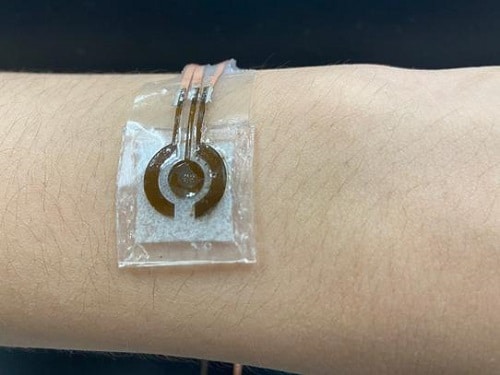With no needles required for collecting blood samples for glucose measurement, the device instead collects sweat to measure sugar levels

Blood sugar and glucose monitoring are often conducted by collecting and analysing a patient’s blood sample. Sometimes, sensors embedded under the skin are also used for such measurement purposes.
Now, researchers at the Pennsylvania State University (Penn State) have developed a non-invasive, low-cost wearable device that can detect glucose in sweat and could soon become the norm.
The device was first created with laser-induced graphene (LIG), a material consisting of atom-thick carbon layers that have high electrical conductivity, conveniently within a few seconds.
But there was a significant challenge.
“The challenge here is that LIG is not sensitive to glucose at all,” said Huanyu “Larry” Cheng, Professor in Department of Engineering Science and Mechanics at Penn State. “So, we needed to deposit a glucose-sensitive material onto the LIG.”
Therefore, the research team chose nickel because of its robust glucose sensitivity and combined it with gold so that even low concentrations of glucose (100x less than the concentration in blood) can be accurately detected in sweat on the skin’s surface.
The nickel-gold alloy has also another benefit – it helps lower the potential risks of an allergic reaction.
“An enzymatic sensor (often used for glucose measurement in invasive procedures) has to be kept at a certain temperature and pH, and the enzyme can’t be stored in the long term,” Cheng said.
“A nonenzymatic glucose sensor, on the other hand, is advantageous in terms of stable performance and glucose sensitivity regardless of these changes.”
Solving another challenge
Despite being advantageous, nonenzymatic sensors require an alkaline solution, which can damage the skin and thus limit the wearing of the device.
To tackle this, a small microfluidic chamber was attached to the LIG alloy that was connected to a collection inlet that passed sweat into the solution without allowing the solution to touch the skin. The basic solution interacted with the glucose molecules to produce a compound that reacted with the alloy, which triggered an electrical signal, indicating the glucose concentration in the sweat.
Because the chamber was porous, the range of movement, such as stretching or crushing increased while wearing the device.
Along with the alkaline solution chamber, the entire device came about roughly the size of a quarter while being flexible enough to securely attach to the human body.
Testing and future plans
To demonstrate the achievement, the researchers used a skin-safe adhesive to attach the reusable device to a person’s arm one hour and three hours after a meal.
To produce an adequate level of sweat for measurement, the person also performed a brief workout. Upon analysing the collected sweat, it was found that the detected glucose concentration dropped from the first measurement to the next. The measurements from the device were verified by measurements made with a commercially available glucose monitor.
The research team further intends to improve upon the prototype for future applications, including addressing how the sensor can be used for incremental glucose measurements or continuous monitoring to determine treatments, such as administering insulin.
The team also wishes to refine and expand this platform for more comfortable monitoring of other biomarkers present in the sweat or interstitial fluids that fill the space between cells in the body.
“We want to work with physicians and other health care providers to see how we can apply this technology for daily monitoring of a patient,” Cheng said. “This glucose sensor serves as a foundational example to show that we can improve the detection of biomarkers in sweat at extremely low concentrations.”
For detailed information, read here







